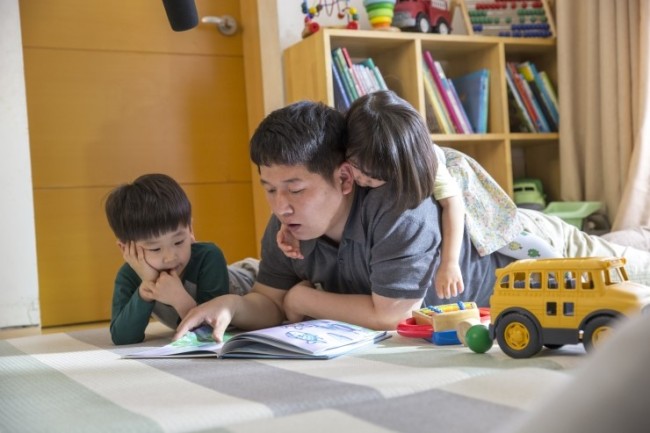Money, patriarchal culture stand in the way of Korean men taking child care leave: study
By Claire LeePublished : May 22, 2018 - 18:07
Kim Dae-seon has been on his second paternity leave since October last year. The civil servant has two children, aged 7 and 2.
“I didn’t initially intend to take child care leave for my second child,” he told The Korea Herald.
“But he was injured during birth, and he still needs to visit a medical clinic every day. So my wife decided to go back to work, and I decided to stay at home and care for him.”
While he thoroughly enjoys his time with his children, he says that not getting monthly paychecks during his leave does not make things easy for him.
“I didn’t initially intend to take child care leave for my second child,” he told The Korea Herald.
“But he was injured during birth, and he still needs to visit a medical clinic every day. So my wife decided to go back to work, and I decided to stay at home and care for him.”
While he thoroughly enjoys his time with his children, he says that not getting monthly paychecks during his leave does not make things easy for him.

“I do get a paternity allowance every month, which is about 500,000 won ($463). Although it’s better than nothing, the amount is incomparable to how much I used to make monthly at work,” said Kim, who is on his yearlong leave.
“Right now, things aren’t too bad for us as my wife is working full time. But I know that this isn’t an option for many couples. And if the husband is the sole breadwinner of a family, I assume it would be very hard for him to make the decision to take his paternity leave and earn only 500,000 won a month.”
Kim is one of some 12,000 South Korean fathers who were on child care leave last year.
Although the number of working fathers taking such leave has been steadily increasing, from 502 in 2009 to 12,043 last year, it is still an option that is not very popular among men.
Among the total of 82,179 Koreans who took child care leave last year, 91 percent were women.
Researchers often point to South Korea’s patriarchal work and family culture as one of the biggest reasons behind why so few Korean men take child care leave.
But recent research suggests that money -- or, low income replacement rate for paternity or child care leave benefits -- may be another significant factor that makes it difficult for working fathers to choose to take the leave to be with their children.
According to a National Assembly Research Service report, paternity leave benefits replace only about 32 percent of previous earnings for working fathers in Korea.
South Korea’s income replacement rate for paternity leave is the lowest among Organization for Economic Cooperation and Development nations, the study said.
According to the study, men in Japan get 58.4 percent of their previous earnings as paternity leave benefits. In Norway, fathers get 97.9 percent of their previous work salary as leave benefits, while fathers in Austria and Sweden receive 80 percent and 77.6 percent of their previous earnings as benefits for the specific leave, respectively.
Last year, about 13.4 percent of all working fathers decided to take child care leave.
While the number is a significant increase from the 4.5 percent in 2013, the study showed that South Korea still has a long way to go.
In Iceland, the study showed, 45.6 percent of all working fathers take child care or paternity leave, while 40.8 percent in Norway and 43.3 percent in Portugal are doing the same.
Kim said Korea’s patriarchal culture is intertwined with the money issue. “Although a lot has changed, I think for many single-income households in our country, most of the breadwinners are still men,” he told The Korea Herald.
“When you are the only one making money for your family, making that decision to be with your child while you only get a very small portion of what you used to make, I assume, is not an easy thing to do.”
According to a study by the Hyundai Research Institute, 55.7 percent of South Korean women aged 15-29 were employed, while the figure for men in the age group came to 75.7 percent as of 2015.
South Korea also has the highest wage gap among OECD countries.
The income replacement rate for child care leave for women is also low in South Korea. As of 2015, Korean women on average received 29 percent of their previous earnings as child care benefits, making single mothers more financially vulnerable and sometimes unable to take child care leave at all.
Heo Min-sook, a researcher at the National Assembly Research Service, said although Korean men tend to take longer leave than those living in Scandinavian countries, their leave benefits are much smaller.
“This may indicate that the income replacement rate is more important than how much time is allowed for fathers to be with their children,” the researcher said.
Kim said taking child care leave has made him think differently about gender roles, regardless of the issues related to finances.
“When my kids face a problem, they look for me first, not their mother,” he said.
“I just came to realize that kids bond with the person that they spend a lot of their time with, not necessarily their moms. We are still used to this idea that mothers ‘naturally’ connect with their kids. I don’t think that’s really the case. Fathers can do an amazing job as parents as well.”
By Claire Lee (dyc@heraldcorp.com)










![[Today’s K-pop] BTS pop-up event to come to Seoul](http://res.heraldm.com/phpwas/restmb_idxmake.php?idx=644&simg=/content/image/2024/04/17/20240417050734_0.jpg&u=)
![[Graphic News] More Koreans say they plan long-distance trips this year](http://res.heraldm.com/phpwas/restmb_idxmake.php?idx=644&simg=/content/image/2024/04/17/20240417050828_0.gif&u=)





![[KH Explains] Hyundai's full hybrid edge to pay off amid slow transition to pure EVs](http://res.heraldm.com/phpwas/restmb_idxmake.php?idx=652&simg=/content/image/2024/04/18/20240418050645_0.jpg&u=20240419100350)

